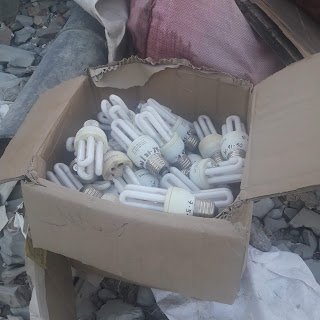Group Calls Out DoE for Unused Lamp Waste Management Facility that Risks Becoming A White Elephant
A waste and pollution watch group has called out the
Department of Energy (DoE) for the non-utilization of a costly facility that is
supposed to provide a solution to the unsafe disposal of mercury-containing
lamp waste.
Through a letter sent to the DoE, the EcoWaste Coalition
drew attention to the Lamp Waste Management Facility (LWMF) that has been
gathering dust since 2014 and could be turning into a white elephant. The letter was sent yesterday to DoE
Secretary Alfonso Cusi and to Energy Research and Testing Laboratory Services
Director Amelia de Guzman.
“Considering the almost five-year delay in getting the
LWMF operational, we call upon the Office of the DoE Secretary to convene an
urgent meeting to apprise the stakeholders about the state of non-operation of
the facility and what can be done to address this matter,” wrote Thony Dizon,
Chemical Safety Campaigner, EcoWaste Coalition.
The group, as part of its work on mercury pollution
prevention, has been writing the DoE regarding the LWMF since August 2016 in
the hope of getting the facility up and running to ensure the proper recycling
of mercury-added lamps.
Health-damaging mercury vapor in a mercury-containing
lamp can be released if it breaks in the waste stream, is dumped, burned or
recycled in uncontrolled conditions, the EcoWaste Coalition said.
According to government information, the DoE in 2013
procured a set of equipment capable of recovering mercury from lamp waste from
MRT System International of Sweden for $1.37 M plus taxes and customs duties.
The establishment of the LWMF, a component of the DoE-led
Philippine Energy Efficiency Project supported by a loan from the Asian
Development Bank, is supposed to address the problem with residual mercury that
is expected to increase with the use of energy efficient but mercury-containing
compact fluorescent lamps (CFLs).
The DoE operated the facility, located at a 1,000 square
meter warehouse in Bagumbayan, Taguig City, during the pilot phase in 2014.
The EcoWaste Coalition is concerned that the non-use of
the facility can affect the expensive and sensitive equipment consisting of a
lamp processor, high-density discharge processor, batch process distiller,
drying oven and vapor monitor.
“The non-operation of the facility for a long time can
take its toll on the equipment, while the improper disposal of mercury lamp
waste persists,” Dizon said.
According to “The Toxic Silence of the Lamps,” a report
by the EcoWaste Coalition, broken and burned-out lamps are generally disposed
of along with ordinary municipal solid waste and hauled to landfill facilities.
“Mercury in lighting products in the form of mercury
vapor is released due to breakage during their use or during their handling,
storage and disposal,” the report said, exposing humans, including waste
workers, to mercury, a highly toxic substance.
“Occupational health risks are generally high for
unprotected waste collectors, haulers and recyclers handling mixed discards in
the municipal solid waste stream with bare face and hands,” the report noted.
Aside from lamp waste, waste workers have to deal with
mercury from other mercury-added products and wastes, including other electronic
waste such as switches and relays, medical devices such as thermometers, skin
whitening cosmetics, dental fillings, etc.
“Exposure to mercury and other hazardous and toxic
substances in the waste stream is a major threat to waste workers’ health,” the
report pointed out.
-end-
Reference:
DoE’s powerpoint presentation on the LWMF
“The Toxic Silence of the Lamps”








Comments